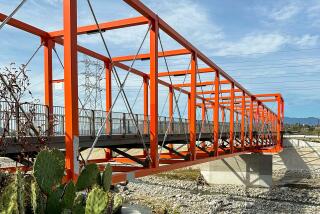After Major Refurbishing, Historic Structure Bridges the Past, Future
- Share via
CHATTANOOGA, Tenn. — For 15 years, the historic Walnut Street Bridge stood silent, a steel silhouette across the Tennessee River closed to traffic as riverfront development grew around it.
That will change this weekend, when the 102-year-old bridge reopens to walkers, bikers, roller bladers and horse-drawn carriages.
“This bridge is one of the pearls on the necklace of the Chattanooga river walk,” said restoration architect Garnet Chapin. “The Tennessee Aquarium is the pendant hanging from the center, but we see this as a very positive contribution to the whole effort to revitalize the riverfront and downtown.”
The 2,370-foot-long bridge, built in 1891, is the oldest surviving truss bridge of its size in the South. It was closed to traffic in 1978 out of fear it would collapse.
City leaders struggled for years over its fate. The bridge finally dodged the wrecking ball after some residents rallied to its rescue.
Since 1991, the bridge slowly has been transformed from a worn metal eyesore to a shimmering tribute to Chattanooga’s history.
Chapin, a Chattanooga native who directed the federal restoration of the Statue of Liberty and Ellis Island, said the thought of demolishing such an important piece of his hometown’s history worried him.
“It was Chattanooga’s treasure,” Chapin said. “I think it shows great foresight on the part of the city to take on such a major project for people purposes.”
Chapin, whose great-grandfather lived near the bridge, spent hours as a child climbing along the bluffs beneath the structure. “It’s influenced all the design work I’ve done,” he said.
The bridge’s structure has been reinforced, brought up to federal and state standards and repainted a bright blue-green. Its asphalt roadway has been replaced with a wooden deck, and it will be completely lighted at night.
For months, the bridge was encased in nylon mesh that trapped the old leaded paint as it was removed from the steel frame.
The method was more time-consuming than anticipated, delaying the opening by a year, Chapin said.
The restoration cost $4.5 million in public and private funds.
The bridge will link the city’s revitalized downtown and riverfront. It will connect the Tennessee Aquarium, a planned outdoor amphitheater, riverside restaurants and shops, Tennessee Riverpark, and the Houston and Hunter art museums.
The only motorized vehicles allowed on the bridge will be the city’s electric buses, which will be restricted to one lane.
Chapin said the reopening will be the high point of his career.
“One of the most gratifying aspects of the project is returning a valuable historical and cultural resource back to the community,” he said. “The people got together and said, ‘this is important to us and we’re going to find a way to save it,’ and we did it.”
More to Read
Sign up for Essential California
The most important California stories and recommendations in your inbox every morning.
You may occasionally receive promotional content from the Los Angeles Times.













